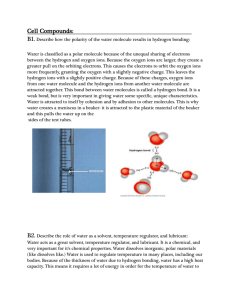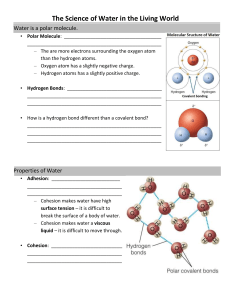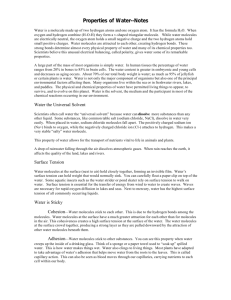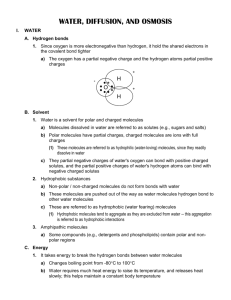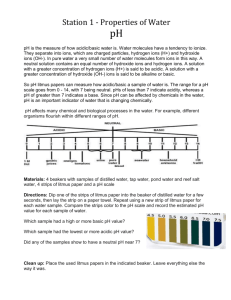Chapter 3 - Properties of Water
advertisement
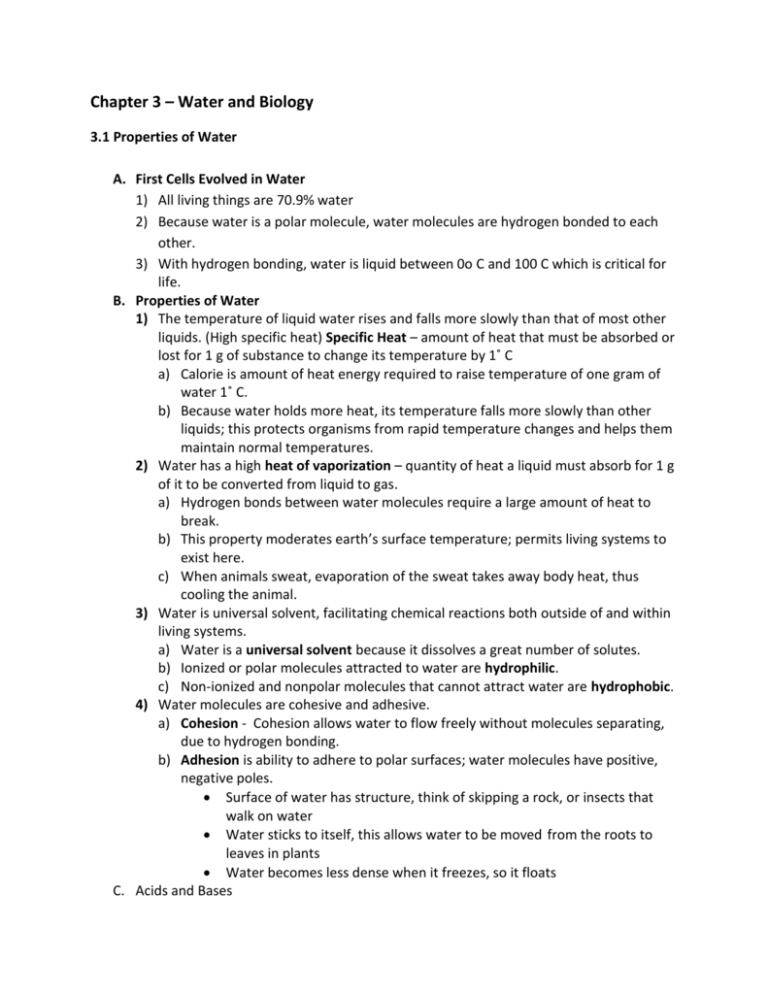
Chapter 3 – Water and Biology 3.1 Properties of Water A. First Cells Evolved in Water 1) All living things are 70.9% water 2) Because water is a polar molecule, water molecules are hydrogen bonded to each other. 3) With hydrogen bonding, water is liquid between 0o C and 100 C which is critical for life. B. Properties of Water 1) The temperature of liquid water rises and falls more slowly than that of most other liquids. (High specific heat) Specific Heat – amount of heat that must be absorbed or lost for 1 g of substance to change its temperature by 1˚ C a) Calorie is amount of heat energy required to raise temperature of one gram of water 1˚ C. b) Because water holds more heat, its temperature falls more slowly than other liquids; this protects organisms from rapid temperature changes and helps them maintain normal temperatures. 2) Water has a high heat of vaporization – quantity of heat a liquid must absorb for 1 g of it to be converted from liquid to gas. a) Hydrogen bonds between water molecules require a large amount of heat to break. b) This property moderates earth’s surface temperature; permits living systems to exist here. c) When animals sweat, evaporation of the sweat takes away body heat, thus cooling the animal. 3) Water is universal solvent, facilitating chemical reactions both outside of and within living systems. a) Water is a universal solvent because it dissolves a great number of solutes. b) Ionized or polar molecules attracted to water are hydrophilic. c) Non-ionized and nonpolar molecules that cannot attract water are hydrophobic. 4) Water molecules are cohesive and adhesive. a) Cohesion - Cohesion allows water to flow freely without molecules separating, due to hydrogen bonding. b) Adhesion is ability to adhere to polar surfaces; water molecules have positive, negative poles. Surface of water has structure, think of skipping a rock, or insects that walk on water Water sticks to itself, this allows water to be moved from the roots to leaves in plants Water becomes less dense when it freezes, so it floats C. Acids and Bases 1) Covalently bonded water molecules ionize; the atoms dissociate into ions. 2) When water ionizes or dissociates, it releases a small (107 moles/liter) but equal number of H+ and OH 3) Water dissociates into hydrogen and hydroxide ions 4) Acid molecules dissociate in water, releasing hydrogen ions (H+) ions: HCl •¨ H+ + Cl5) Bases are molecules that take up hydrogen ions or release hydroxide ions. NaOH •¨ Na+ + OH-. 6) The pH scale indicates acidity and basicity (alkalinity) of a solution. a) One mole of water has 107 moles/liter of hydrogen ions; therefore, has neutral pH of 7. b) Acid is a substance with pH less than 7; base is a substance with pH greater than 7. c) As logarithmic scale, each lower unit has 10 times the amount of hydrogen ions as next higher pH unit 7) Buffers keep pH steady and within normal limits in living organisms. 8) Normal cells have internal pH of 7. Any change up or down can have drastic results.







